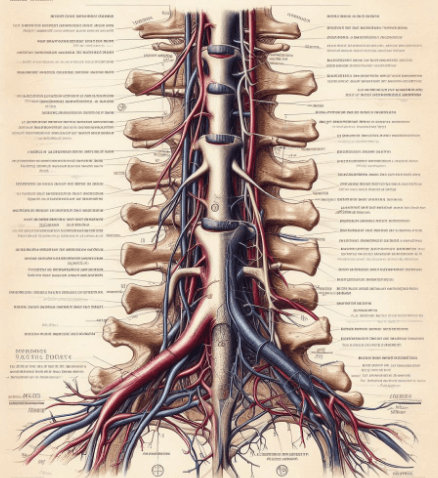Quick Overview
Anterior spinal artery (ASA) is one of the three main arteries that supply blood to the spinal cord.It originates from the vertebral artery and descends along the anterior surface of the spinal cord, supplying blood to the anterior two-thirds of the cord. The ASA terminates at the conus medullaris, the tapered lower end of the spinal cord.

Table of Contents
Anterior Spinal Artery Anatomy
The ASA, is a singular vessel, typically arises from the vertebral arteries, which are branches of the subclavian arteries. It travels along the ventral (front) surface of the spinal cord, running within the anterior median fissure.
| Artery | Description |
| Origin | Vertebral artery |
| Branches | Central branches, Lateral branches, Radicular branches |
| Supply | Anterior two-thirds of the spinal cord, Central gray matter of the spinal cord, Lateral white matter of the spinal cord, Nerve roots |
Branches
The ASA has a number of branches, including:
Central branches: These branches supply blood to the central gray matter of the spinal cord.
Lateral branches: These branches supply blood to the lateral white matter of the spinal cord.
Radicular branches: These branches supply blood to the nerve roots as they exit the spinal cord.
Supplies
The ASA supplies blood to the following structures:
- Anterior two-thirds of the spinal cord
- Central gray matter of the spinal cord
- Lateral white matter of the spinal cord
- Nerve roots
Anterior Spinal Artery Syndrome
Anterior Spinal Artery Syndrome (ASAS) is a neurological condition that arises from a disruption in the blood flow through the Anterior Spinal Artery (ASA), which supplies oxygen and nutrients to the anterior two-thirds of the spinal cord. This syndrome can have profound effects on motor, sensory, and autonomic functions, depending on the level of the spinal cord affected.
Causes:
Anterior Spinal Artery Syndrome (ASAS) is a neurological condition caused by the disruption of blood flow through the Anterior Spinal Artery (ASA). The primary causes include:
1- Atherosclerosis: Buildup of fatty deposits in the ASA, narrowing the artery and reducing blood flow.
2- Thrombosis: Formation of blood clots within the ASA.
3- Embolism: Migration of clots or debris from other parts of the body, obstructing the ASA.
4- Vasculitis: Inflammation of blood vessels affecting ASA function.
5- Trauma: Severe spinal cord injuries or trauma disrupting ASA blood flow.
Symptoms:
Symptoms of ASAS can vary based on the location and extent of spinal cord involvement but some of the common signs and symptoms include:
- Motor Dysfunction: Weakness or paralysis in limbs or trunk, often affecting both sides.
- Sensory Loss: Decreased or loss of sensation in areas supplied by the affected spinal cord segment.
- Autonomic Dysfunction: Problems with bladder and bowel control, blood pressure regulation, and temperature control.
- Pain: Sharp, burning pain in the affected area.
- Respiratory Issues: Severe cases can impact breathing muscles, leading to respiratory distress.
Treatment:
Treatment strategies for ASAS depend on the underlying cause and the severity of symptoms, however some common treatment are:
- Management of Underlying Conditions: Address and manage factors contributing to ASAS, such as atherosclerosis, blood clotting disorders, or vasculitis.
- Rehabilitation: Physical and occupational therapy to improve motor and sensory function.
- Symptom Management: Medications for pain relief, muscle spasms, and other symptoms.
- Surgery: In some cases, surgical intervention may be necessary to remove obstructions or repair damaged blood vessels.
Anterior spinal artery stroke (ASAS)
Anterior spinal artery stroke (ASAS) is a stroke that occurs when the blood supply to the anterior spinal artery (ASA) is blocked.
The ASA is one of the three main arteries that supply blood to the spinal cord. It originates from the vertebral artery and descends along the anterior surface of the spinal cord, supplying blood to the anterior two-thirds of the cord.
Causes
The most common cause of ASAS is atherosclerosis, a condition in which plaque builds up on the walls of the arteries, narrowing them. Other causes of ASAS include:
- Blood clots
- Dissection of the aorta or vertebral artery
- Spinal stenosis
- Spinal cord injury
- Infection
Symptoms
The symptoms of ASAS depend on the level of the blockage in the ASA. Symptoms may include:
- Weakness or paralysis of the legs
- Loss of sensation below the level of the blockage
- Urinary and bowel incontinence
- Priapism (erection of the penis that is not caused by sexual stimulation)
- Loss of temperature control below the level of the blockage
Treatment
There is no specific treatment for ASAS. Treatment is focused on preventing further damage to the spinal cord and improving the patient’s quality of life. Treatment options may include:
- Medications to reduce inflammation and pain
- Physical therapy to help patients regain strength and mobility
- Occupational therapy to help patients learn to perform activities of daily living
- Surgery to remove the blockage in the ASA if other treatments are not successful
